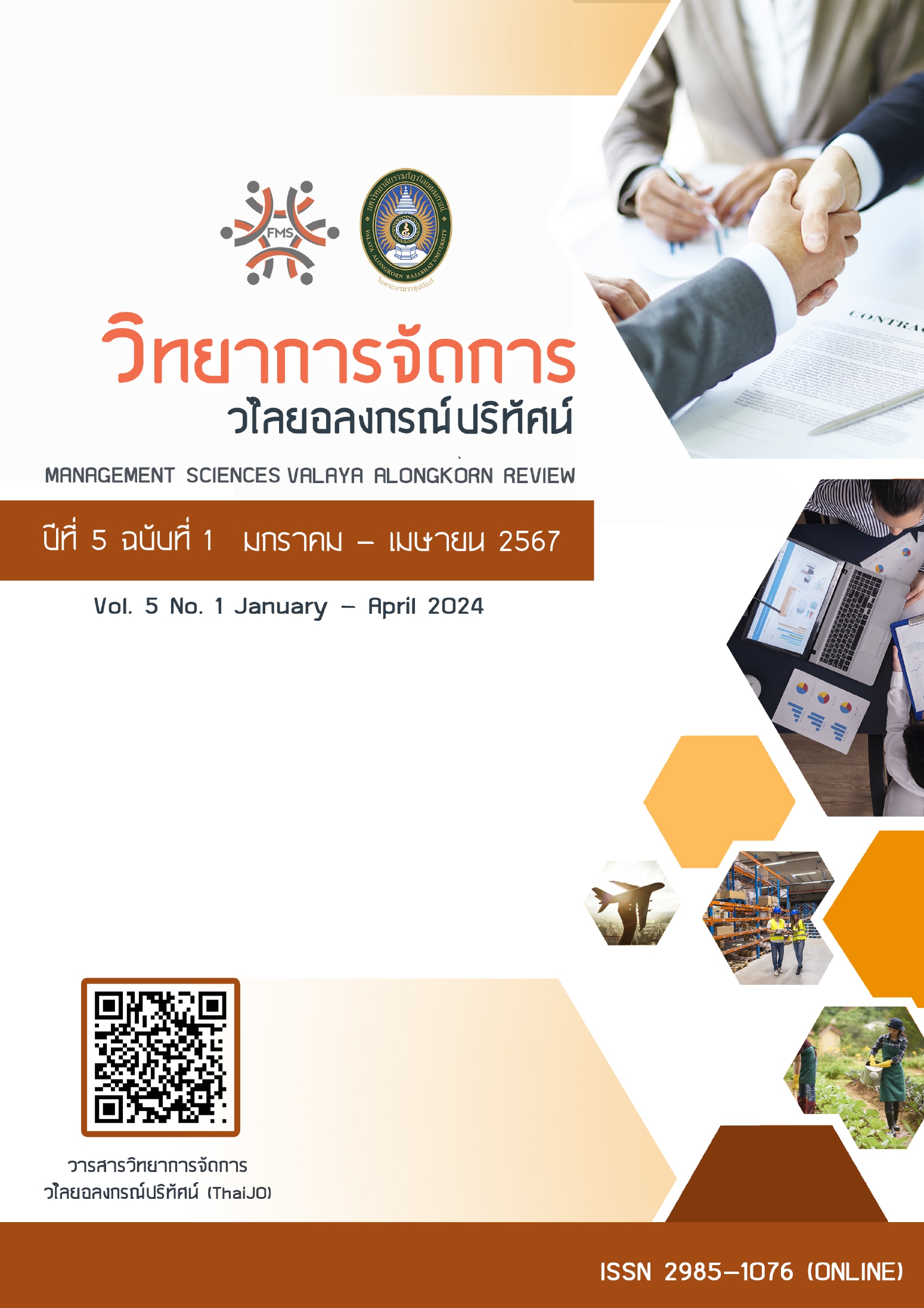การศึกษาการจัดการฐานข้อมูลลูกค้าในการบริหารลูกค้าสัมพันธ์ของภาคธุรกิจในจังหวัดลพบุรี
Main Article Content
บทคัดย่อ
การวิจัยครั้งนี้มีวัตถุประสงค์เพื่อศึกษาความสัมพันธ์ระหว่างการจัดการฐานข้อมูลลูกค้ากับการบริหารลูกค้าสัมพันธ์ของธุรกิจในจังหวัดลพบุรี และศึกษาการบริหารลูกค้าสัมพันธ์จากการจัดการฐานข้อมูลลูกค้าที่ส่งผลต่อผลการดำเนินงานของธุรกิจในจังหวัดลพบุรี กลุ่มตัวอย่างที่ใช้ในการวิจัย ได้แก่ พนักงานระดับหัวหน้างานหรือผู้บริหารของธุรกิจในจังหวัดลพบุรี จำนวน 400 คน เครื่องมือที่ใช้ในการวิจัยเป็นแบบสอบถามมาตราส่วนประมาณค่า 5 ระดับ สถิติที่ใช้ในการวิเคราะห์ข้อมูล ได้แก่ ค่าร้อยละ ค่าเฉลี่ย ส่วนเบี่ยงเบนมาตรฐาน การวิเคราะห์ค่าสัมประสิทธิ์สหสัมพันธ์เพียร์สัน และการวิเคราะห์ความถดถอยเชิงพหุคูณ
ผลการวิจัยพบว่า ผลการวิเคราะห์ความสัมพันธ์ระหว่างการจัดการฐานข้อมูลลูกค้ากับการบริหารลูกค้าสัมพันธ์ พบว่า มีความสัมพันธ์เชิงบวกในระดับปานกลาง โดยการจัดการฐานข้อมูลลูกค้ามีความสัมพันธ์กับการบริหารลูกค้าสัมพันธ์สูงสุด 3 อันดับแรก คือ ข้อมูลการใช้จ่าย ข้อมูลพฤติกรรมการซื้อ และข้อมูลปฏิสัมพันธ์ ผลการวิเคราะห์การบริหารลูกค้าสัมพันธ์จากการจัดการฐานข้อมูลลูกค้าที่ส่งผลต่อผลการดำเนินงานของธุรกิจ พบว่า การบริหารลูกค้าสัมพันธ์ส่งผลเชิงบวกต่อผลการดำเนินงานของธุรกิจ โดยร่วมกันพยากรณ์ผลการดำเนินงานได้ร้อยละ 78.9
Article Details

อนุญาตภายใต้เงื่อนไข Creative Commons Attribution-NonCommercial-NoDerivatives 4.0 International License.
บทความ ข้อความ ภาพประกอบ และตารางประกอบที่ลงพิมพ์ในวารสารเป็นความคิดเห็นส่วนตัวของผู้นิพนธ์ ถือเป็นความรับผิดชอบของผู้นิพนธ์แต่เพียงผู้เดียว กองบรรณาธิการไม่จำเป็นต้องเห็นตามและไม่มีส่วนรับผิดชอบใด ๆ
เอกสารอ้างอิง
กัลยา วินิชย์บัญชา. (2560). การใช้ SPSS for Windows ในการวิเคราะห์ข้อมูล. (พิมพ์ครั้งที่ 30). กรุงเทพฯ: สามลดา.
ธานินทร์ ศิลป์จารุ. (2563). การวิจัยและวิเคราะห์ข้อมูลทางสถิติด้วย SPSS และ AMOS. นนทบุรี : เอส. อาร์.พริ้นติ้ง แมสโปรดักส์.
ธีระ กุลวรวิทย์. (2564). ปัจจัยคุณภาพ ความคุ้มค่าของการใช้บริการ และการบริหารลูกค้าสัมพันธ์ที่ส่งผลต่อพฤติกรรมการเลือกใช้บริการขนส่งพัสดุของผู้ประกอบการ Social Commerce ในประเทศไทย. (วิทยานิพนธ์หลักสูตรปริญญาบริหารธุรกิจมหาบัณฑิต)
วิทยาเขตตรัง: มหาวิทยาลัยสงขลานครินทร์.
สำนักงานคณะกรรมการข้อมูลข่าวสารของราชการ. (2565) เป้าหมายการพัฒนาจังหวัดลพบุรี 20 ปี (2566-2585). สืบค้นจาก, https://www.oic.go.th/FILEWEB/CABINFOCENTER2/DRAWER059/GENERAL/DATA0000/00000276.PDF.
หทัยชนก ว่องเจริญพร. (2565). การตลาดดิจิทัลที่ส่งผลต่อความพึงพอใจและความภักดีของลูกค้า. (วิทยานิพนธ์หลักสูตรบริหารธุรกิจมหาบัณฑิต). อุตรดิตถ์: มหาวิทยาลัยราชภัฏอุตรดิตถ์.
Akhter, S., Rahman, N., & Ullah, M. (2019). Development of a Customer Information Database System. In Handbook of Research on Technology Integration in the Global World.
Al-Ayed, S., & Al-Tit, A. (2024). The impact of digitized customer behaviors on performance: The mediating and the moderating role of digitized CRM. International Journal of Data and Network Science, 8(1), 189-194.
Cavaliere, L. P. L., Khan, R., Sundram, S., Jainani, K., Bagale, G., Chakravarthi, M. K., & Rajest, S. S. (2021). The Impact of customer relationship management on customer satisfaction and retention: The mediation of service quality. Turkish Journal of Physiotherapy and Rehabilitation, 32(3), 22107-22121.
Chen, H., & Zhang, H. (2019). Data-Driven Operations in the Era of Industry 4.0. International Journal of Production Economics, 208, 106-112.
Cronbach, L. J. (1990). Essentials of psychological testing (5th ed.). New York: Harper Collins Publishers.
Davenport, T. H., & Harris, J. (2017). The Age of Analytics: Competing in a Data-Driven World. Harvard Business Review, 95(1), 1-10.
Drosos, D., Skordoulis, M., & Chalikias, M. (2019). Measuring the Impact of Customer Satisfaction on Business Profitability: An Empirical Study. International Journal of Technology Marketing, 13(2), 143–155.
Government Data Catalog. (2023). จำนวนสถานประกอบกิจการในพื้นที่จังหวัดลพบุรี. สืบค้นจาก, https://gdcatalog.go.th/dataset/gdpublish-dataset.
Gutterman, A. S. (2023). Organizational Performance and Effectiveness. Retrieved from, https://www.researchgate.net/publication/372935897_Organizational_Performance_and_Effectiveness.
Kaplan, R. S., & Norton, D. P. (2004). Strategy Maps: Converting Intangible Assets into Tangible Outcomes. Harvard Business Press.
Li, Y., Li, Y., and Shi, Y. (2020). Big Data in Marketing: A Review and a Research Agenda. European Journal of Marketing, 54(1), 5-32.
Mandal, P. C. (2022). Roles of Customer Databases and Database Marketing in Customer Relationship Management. International Journal of E-Business Research (IJEBR), 18(1), 1-12.
Micheaux, A., & Bosio, B. (2019). Customer Journey Mapping as a New Way to Teach Data-Driven Marketing as a Service. Journal of Marketing Education, 41(2), 127–140.
Pham, T. (2021). Impact of Customer Analytics Use on CRM. Karistad Business School.
PricewaterhouseCoopers (PwC). (2021). The Global State of Information Security Survey 2021. PwC.
Rane, N., L., Achari, A., & Choudhary, S., P. (2023). Enhancing Customer Loyalty through Quality of Service: Effective Strategies to Improve Customer Satisfaction, Experience, Relationship, and Engagement. International Research Journal of Modernization in Engineering Technology and Science, 5(5), 427-452.
Rane, N., Choudhary, S., & Rane, J. (2023). Hyper-Personalization for Enhancing Customer Loyalty and Satisfaction in Customer Relationship Management (CRM) Systems. Retrieved from, https://papers.ssrn.com/sol3/.
Sheth, J. (2017). Revitalizing relationship marketing. Journal of Services Marketing, 31(1), 6-10.
Thuong, C., V., & Singh, H. (2023). The Impact of a Balanced Scorecard on Enterprise Performance in Ho Chi Minh City, Vietnam. International Journal of Organizational Leadership, 12, 198-215.
West, J., and Bogers, M. (2017). Leveraging External Sources of Innovation: A Review of Research on Open Innovation. Journal of Product Innovation Management, 34(3), 261-280.
Yildiz, S., & Karaka, A. (2012). Defining Methods and Criteria for Measuring Business Performance: a Comparative Research Between the Literature in Turkey and Foreign. Procedia-Social and Behavioral Sciences, 58, 1091-1102.
Zipdo. (2023). Essential Manager to Employee Ratio Statistics In 2024. Retrieved from, https://zipdo.co/statistics/manager-to-employee-ratio/.


